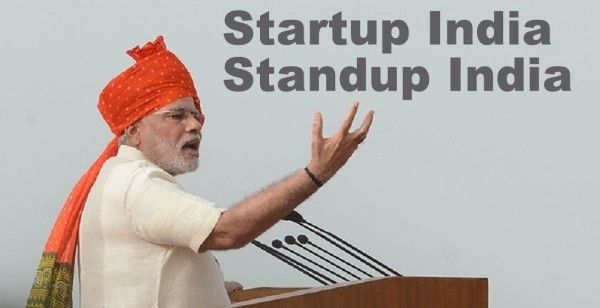Start up India – Stand up India Scheme : Main Highlights

Dear Sehpaathians,
As LIC AAO Interviews are just around the corner. You can expect Questions from different fields; therefore it is essential to have sound knowledge about them. Few months back, a very important scheme was launched i.e. Startup India Standup India which is very important considering the interview and upcoming exams.
So here we present an article on this, covering every essential aspect of the scheme.
Startup India Standup India was first mentioned by PM Narendra Modi on August 15, 2015 while addressing the nation on Independence Day. However the scheme was formally launched on January 16, 2016 in New Delhi by PM Modi.
The scheme aims to push for Entrepreneurship in the country by providing enabling environment for the entrepreneurs.
Among 1500 delegates that attended the ceremony are Softbank founder Masayoshi Son and Uber founder Travis Kalanick. On this occasion, the Prime Minister also unveiled Start-up India, Stand-up India Action Plan which contained a slew of financial, policy and regulatory measures aimed at giving impetus to innovation and entrepreneurship in the country.
The features of the Action Plan are as follows:
1. Funds of Fund worth Rs 10,000 Crore will be created, for development and growth of innovative enterprises.
2. Credit Guarantee Fund – Rs 500 Crore per year over next 4 years.
3. Profits of Start-up units will be tax-free for 3 years.
4. No labour Inspection for 3 years instead self-certification based regime to be followed.
5. Quicker and subsidized (i.e. 80%) patent clearance mechanism to be evolved.
6. New mobile App to register Start-ups & apply for Online Clearances will be operational from April 1, 2016.
7. Provision of easier exits (within 90 days) for failed ventures under the Bankruptcy and Insolvency Bill, 2015.
Complete Banking Interview Preparation Material
Complete review of SAARC Ministerial visit
8. 500 sector specific incubators, including 5 new Bio clusters will be established across the country.
9. Under this, 35 new incubators, 7 new research parks, 31 innovation centers will be set up at the National institutes under the public private partnership mode.
10. Under Atal Innovation Mission, seeds fund and Pre- incubation training will be given.
11. Capital gains tax to be exempted for venture capital investments. The exemption,however, will be applicable only when only when the proceeds are invested in another startup.
12. An innovation programme will be launched in 5 lakh schools across the country to nurture innovation among 10 lakh children.
13. To protect intellectual Property Rights, a new scheme will be developed.
Impact of this policy in the long run:
1. This policy will encourage entrepreneurship.
2. It will create new employment opportunities for the unemployed.
3. It will also promote entrepreneurship among SC/ST and Women Entrepreneurs.
4. It is expected to benefit at least 2.5 lakh borrowers.
5. It will restrict the role of state and facilitate ease of doing business.
Challenges in implementation: There are few things which are pre- requisite for successful implementation of the scheme. They are:
- Electricity
- Internet connectivity
- Roads
- Clean environment
- Corruption
Current Statistics for startups:
1. With 4200 startups registered in India, India ranks 3rd globally.
2. Indian startups draw $18 billion during 2010-15 including $9 billion in 2015 alone.
3. 9 Indian startups have been valued at more than a billion dollars.
4. Increase in number of incubators: 80 in 2014, 110 in 2015; 50% outside Delhi, Bengaluru, and Mumbai.
























